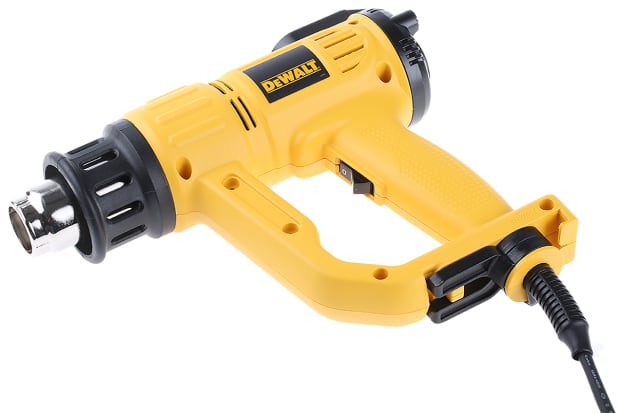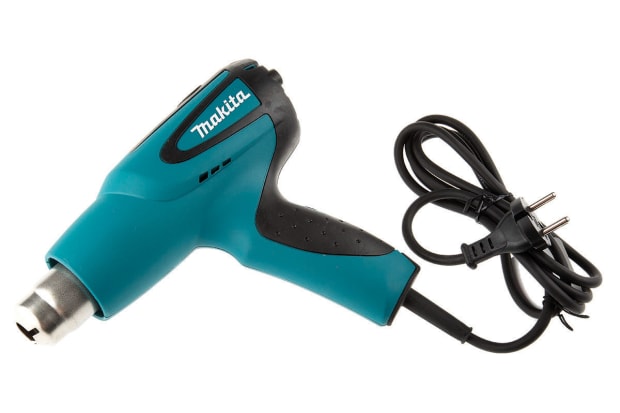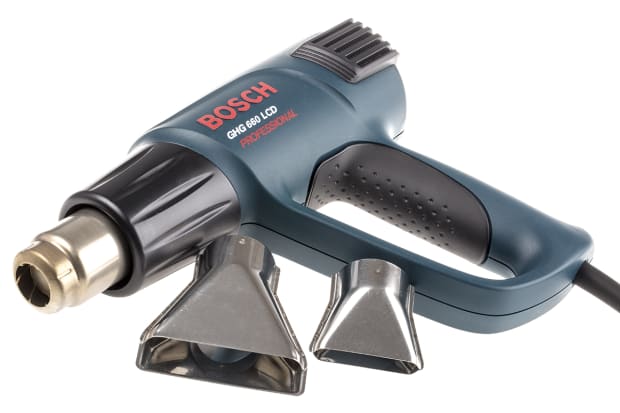- Published 5 Jan 2023
- Last Modified 4 Sept 2023
- 12 min
The Complete Guide to Heat Guns

What are heat guns?
Heat guns are electric hand tools which look and work in a similar way to hair dryers – operating a fan that pulls air into the body of the tool and drives it across an electric heating element and out through a nozzle. Heat guns are sometimes referred to as hot air guns.
Heat guns are lightweight, easy-to-use tools which are less likely than blow torches to scorch wood or crack glass when being used. This means they’ve predominantly replaced the old-fashion paraffin and bottled gas blow torch for stripping paint on timber.
The hot air flow of a heat gun is less dangerous than a naked flame but it can still cause flammable items to catch fire, crack glass and cause injury if directed on to the skin.
Fact: How hot is a heat gun? Most regular heat guns have a minimum temperature of around 49°C (120°F)
One advantage of this tool is the heat is almost instantaneous, so it can be switched off during pauses while working – whereas flame blow torches need to be relit if the flame is extinguished, which is less convenient.
While flames can damage the surface being heated and potentially cause a fire, the hot air from a heat gun is a safer source of heat. For most jobs, 399°C (750°F) is hot enough, and many heat guns allow you to adjust the temperature.
What types of heat gun are available?

Infrared Heat Guns
These heat gun applies infrared heat instead of hot air. An infrared heat gun can reach scorching temperatures, from around 400 to 600°C (752 to 1,112°F). As well as being affordable, infrared heat guns are also a good choice to avoid toxic fumes that are given off by conventional heat guns.
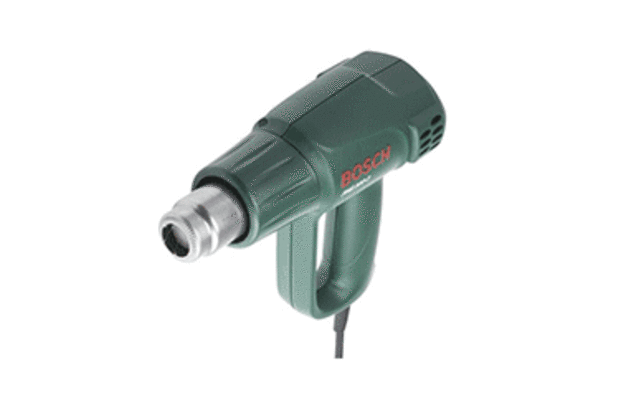
Industrial Heat Guns
These power tools are used for more challenging tasks, as they provide above-average air power. Engineering, automotive, construction and retail packaging are some of the main industries which use industrial heat guns. This type of heat gun has ceramic heating elements and reaches temperatures up to 1,000°C (1,800°F).
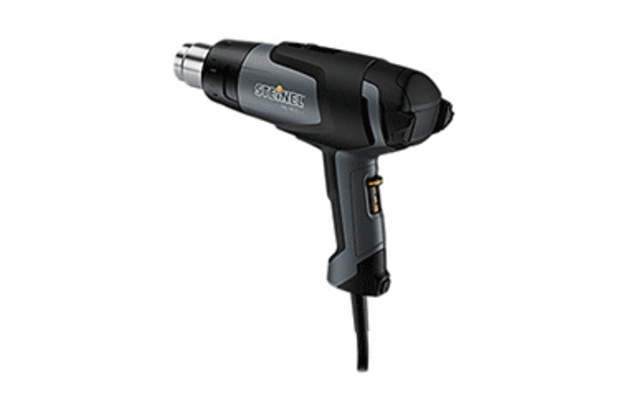
Corded Heat Guns
These heat guns are powered by electricity. When using one in high-up or awkward areas, be aware of the cord’s location and consider using an extension cord to make sure it reaches.
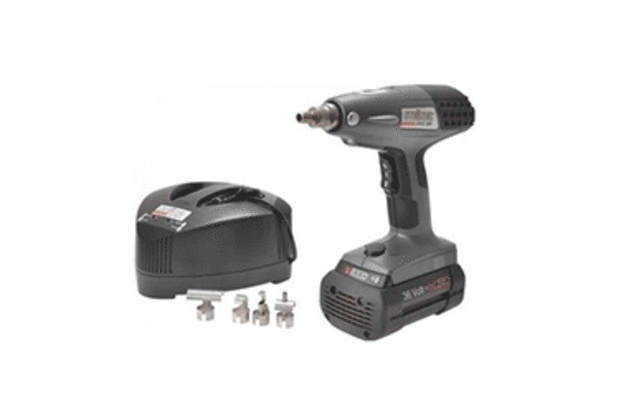
Cordless Heat Guns
Cordless ones are battery powered heat guns, so there’s no need to plug into the mains. This type is convenient and can be used almost anywhere inside or outside.
Features of heat guns
As a simple hand tool, there aren’t many differences between the various models of a heat gun, but here are some important features to consider:
- Wattage – this refers to the power of the heat gun. They commonly range from 1,000W to 2,000W. If there are heat and/or airflow controls, the higher the wattage, the more effective it is.
- Power switch – it’s normally a dead man switch so that power is turned off when finger pressure is removed, which is a good safety feature as the heat gun stops if it’s accidentally dropped.
- Variable temperature setting – a choice of temperature controls makes the tool more useful.
- Airflow setting – having variable or more than one setting makes the heat gun more versatile.
- Thermal cut out – this switches off the tool if it overheats.
- Hanging hook – useful for storage.
- Surface stand – this enables the heat gun to be safely rested during pauses. It also allows the gun to be used hands-free when two hands are required on the task, for example when bending a plastic pipe.
How do you use a heat gun?
Standard heat guns have just one heat setting and one fan speed and are designed mainly for paint stripping.
More complex models have two or three heat settings or even a variable adjustment within a heat range, combined with a choice of two, three or variable speeds of air flow.
When using a heat gun to strip paint, the heated air is directed on to the painted surface, helping it to soften so that it can be easily stripped off.
The tool is used one-handed, with the other hand to hold the stripping tool. Heat guns are really effective for getting rid of a build-up of paint. Usually the gun should be held approximately four inches away from the painted wood, but check the manufacturer’s instructions for proper distance and degree of heat for each project.
Move the gun around, as holding it still in one can cause charring or burning of the wood. Hold the heat gun with one hand and use a putty knife or scraper to go along behind the gun and scrape away the loosened paint.
Some heat guns can be used on a stand so that both hands are free to work with other tools alongside the hot air. To get the most effective temperature, any heat gun can be held further away from the surface to reduce the heat, but having variable settings offers more choice.
Most heat guns are compatible with interchangeable nozzles, helping to optimise how the tool works on different surfaces and tasks.
While the typical nozzle is an open and even heat output, there are different types of nozzles that can concentrate, protect, reflect or distribute the air.
Special nozzles are available for most models of heat gun for specific uses other than stripping paint and are generally sold separately. These main types are listed below:

Reducer Nozzle
Used for concentrating the heat onto a specific area. It’s ideal for soldering jobs as well as bending plastic tubing.
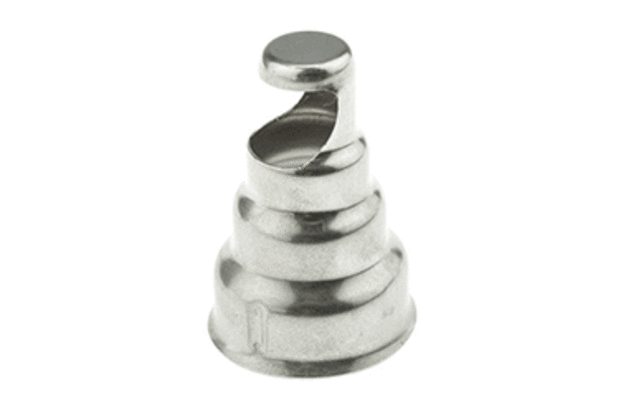
Reflector Nozzle
Wraps around a plastic or copper pipe to spread the heat around the pipe surface. Perfect for bending plastic tubing, soldering copper pipes, applying heat shrink tubing.

Surface Nozzle
Used for spreading the hot air over a wider narrower area. A surface nozzle can be used to remove old floor coverings or vinyl at a very high temperature.

Glass Protection Nozzle
To be used when stripping paint on a window to keep the direct heat off the glass.
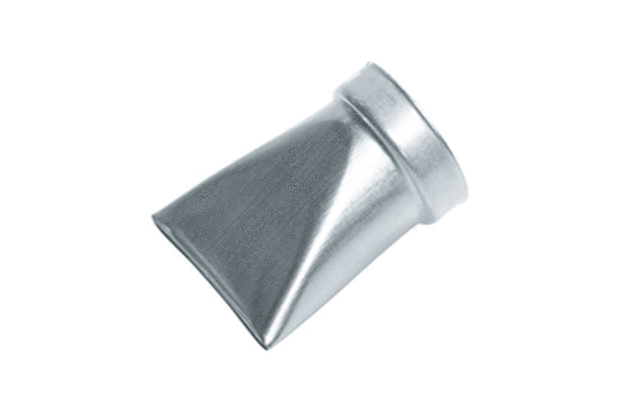
Slot Nozzle
This nozzle is attached to a small-diameter reduction nozzle. This combination is ideal for welding PVC tarpaulin.
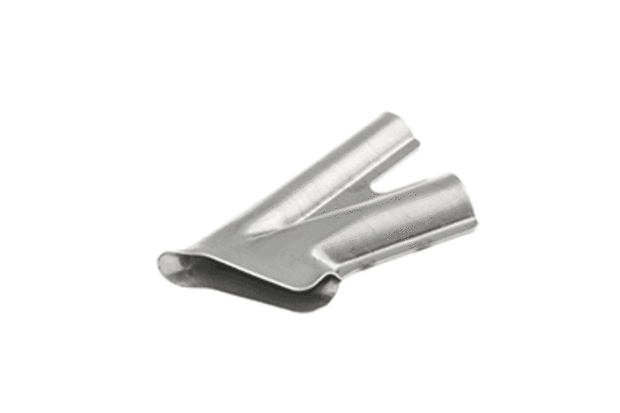
Welding Nozzle
A welding nozzle is also attached to a small-diameter reduction nozzle. If being used to weld plastic, guide welding rods of the appropriate material through the nozzle. The rods then melt in the weld seam.
How to stay safe when using a heat gun
Regular heat guns can reach up to 650°C (1,200°F), meaning they could cause serious burns if used without putting the proper precautionary measures in place first. Although a naked flame is more dangerous than the hot air from a heat gun, the tool still causes other things to crack or catch fire, leading to shattered glass or injuries.
Here are some ways to ensure safety when using heat guns:
- Buy a heat gun from a reputable supplier, and follow the manufacturer’s instructions carefully.
- Wear safety goggles and heat-resistant gloves when using a heat gun, as well as a respirator mask if working in a restricted area.
- Check the appliance has a UK plug and if it doesn’t don’t try using a travel adaptor. Get in touch with the retailer and ask them to fit a UK plug.
- Before you start work, ensure that the cord is long enough to easily reach the area you’re working in – if it isn’t, plug the heat gun into an extension lead to extend your reach.
- It’s always prudent to keep a fire extinguisher on hand in case of any problems.
- Tie back long hair and don’t wear any loose clothing.
- Be sure to have good ventilation in the area where the heat gun is being used.
- Children, animals and pregnant women shouldn’t be nearby when a heat gun is being used to strip paint, as the fumes emitted by the melting paint could be harmful.
- Make sure any surfaces are free from debris like shavings and sawdust as they could catch on fire.
- Always use the heat setting recommended by the manufacturer.
- Don’t block the air inlet grills on the heat gun when it’s being used.
- When the job is finished, place the heat gun on a heatproof surface and leave it to cool completely before putting it away.
What are heat guns used for?
Using heat guns for removal
Removing paint is the most common job for this tool, but heat guns can be used for lots of other things as well. They’re effective for removing stubborn stickers and labels on items like vases, drinking glasses, plates or windows as they warm the adhesive.
As well as that, heat guns help remove old paint drips off the floor by warming the paint until it bubbles, before it can be carefully scraped it off.
Using heat guns for softening
Substances that begin soft or as a liquid before they harden can largely be softened again with the use of a heat gun. Candle wax that’s dripped on to a hard surface, for example, can quickly harden and leave a residue. By melting the wax with a heat gun its liquid form can be wiped away.
Plumber’s putty that’s hardened against pipes, tiles or porcelain can be difficult to remove. It’s easier to do if the putty is initially softened by applying heat and then scraping at the base where it meets the surface.
Using heat guns for repairs
Plastic components and joints in pipes can be repaired with the use of heat, as it enables the materials to be moulded and welded. Heat guns can also be used with the compounds required to repair vinyl-covered furniture, flooring and baseboards.
Using heat guns for soldering and desoldering
Heat guns are an inexpensive way to reflow or reattach electronic components which have been soldered together, as well as an effective way to solder copper pipes.
Other uses for heat guns
There are other uses of the heat gun where having lower air flows and/or lower temperature ranges can be useful, such as:
- Drying paint or varnish – 30 to 130°C (but take care as dust particles may be blown on to the paint/varnish).
- Drying out damp wood (before filling or painting) – 100 to 200°C.
- Bending plastic pipes – 200 to 300°C.
- Heat-shrinking plastic film – 200 to 300°C.
- Welding plastics – 330 to 400°C.
Besides home repair, heat guns are used in engineering, physics, chemistry and science as well as other fields – but there are also some more unusual jobs where heat guns can be used. Here are our top 10 uses for heat guns:
-
Phone screen repair – heat guns can be used to remove damaged phone screens. Slowly heat the surface with the gun set to low and about eight to ten inches from the phone. The adhesive will become pliable enough to work with.
-
Repairing games consoles – heat guns can be used to solder components on a motherboard. For further information on this topic, see our single board guide.
-
Refreshing black tyres – by gently heating the plastic, it brings out the oils in the material which restores the colour.
-
Moulding hockey skates – using a heat gun has the main benefit of only heating the area that you want to mould, so there’s less risk of other parts of the boot getting deformed or damaged.
-
Removing crayon from walls – heat the markings and allow it to warm the wax, then wipe the wax off with a cloth soaked in hot, soapy water.
-
Shining shoes or boots – use a heat gun to get the perfect shine by holding it one to two feet away from freshly waxed shoes/boots. Heat the wax until it shines and melts into the pores of the leather. A haze will form on the cooling wax, so dip a clean cotton ball in water and rub the wax until the haze fades.
-
Waxing jackets – after working the wax into the outside of the jacket, use a heat gun to warm it. This will ensure an even, soaked-in finish.
-
Demist headlights – restore headlights from condensation by using a heat gun to evaporate the mist.
-
Defrosting a freezer – unplug the freezer, prop open the freezer door and remove all food items inside. Aim the heat gun from the floor up into the inside of the freezer and watch all of the ice melt away.
-
Cleaning a grill – use the heat gun to loosen all the debris and a brush to scrape it off, keeping the heat gun moving the entire time.
What is the best heat gun to use?
Cheap heat guns are usually quite limited, so they contain only one heat setting – particularly those designed only for stripping paint. If the heat gun is only in use occasionally or for simple jobs, it could be worth buying a cheaper one with limited features. It’s also worth considering the shape and size of the heat gun as this impacts the proficiency of handling the tool, which affects comfort and safety.
Heat guns that have at least two power settings have better airflow speeds and some offer different temperature settings – ideal if the tool is used for a variety of tasks. It’s also worth considering whether a cordless or corded design would be better suited to the job being carried out. More information on the pros and cons of cordless and corded power tools can be found in our cordless drills guide.
Product Spotlight
RS offers a wide range of heat guns, including products from our own in-house line. Click the video below to see the RS PRO heat gun in use:
Popular Heat Gun Brands
For the most popular brands of Heat Gun, click below to view the full product range:
Related links
- A Complete Guide to Heat Lamps
- Weller 6966E 427°C max Corded Heat Gun, Type F - Schuko plug
- Bosch EasyHeat 500 500°C max Corded Heat Gun, Type G - British
- Heat Sink Buying Guide
- Rapid Hot Air Nozzle for use with Hot air gun
- RS PRO Hot Air station 700W, 220 → 240V
- A Complete Guide to Grease Guns
- Everything You Need to Know About Laminators

